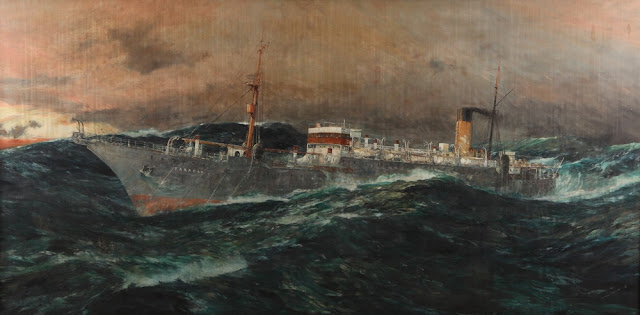Joe Selby, (American, 1893-1960)
Steamship Mary Weems, c. 1926
Oil on board
18 x 25 in
Private collection
Private collection
The Mary Weems was the first passenger steamer to enter the Port of Palm Beach, and a big deal was made of the event. She was greeted by the mayors of West Palm Beach, Palm Beach, Lake Worth, Riviera Beach and Kelsey City (now Lake Park), together with leaders of area clubs and organizations, “bathing girls, airplanes, yachts and bands,” and a seaplane carrying a reporter and photographer from the Palm Beach Daily News.
After one day in port, the Mary Weems left for Miami. The Mary Weems made the three-day run from Philadelphia and Baltimore, charging $75.21 for the round trip including “meals and berth.” The ship sported “best cuisine and service” and “every modern convenience” — rooms with twin beds, showers and baths, and hot and cold running water. Built in 1918 at Elizabeth, New Jersey, this ship was originally named the “Plainfield.” She was purchased at some point prior to 1925 by the Baltimore and Carolina Steamship Company and operated as the “Mary Weems”, apparently named after a relative of the owner of the company. She was sold to the Portland California Steamship Company in late 1927, renamed the “Admiral Peopl,” and was operated by the Admiral Line on a Portland to California route between late 1927 and 1933. She was again sold, in 1934, to Northland Transportation Company, who renamed her the “North Sea”. She met her demise when she was stranded on the coast of British Columbia in 1947. More on Steamship Mary Weems,
The CS Faraday was a cable ship built for Siemens Brothers and launched in 1874.
Faraday was specially designed for ocean cable-laying by William Siemens in collaboration with his friend William Froude, the pioneer of hull design. Faraday spent the next 50 years laying an estimated total of 50,000 nautical miles (93,000 km) of cable for Siemens Brothers, including several transatlantic cables. She was sold for scrap in 1924 but proved to be too difficult to break up and was resold to the Anglo-Algiers Coaling Company for use as a coal hulk, being renamed Analcoal. She was moved to Gibraltar in 1931 to store coal and then to become a Royal Navy storeship in Sierra Leone in 1941. She was towed to a South Wales breakers yard for scrap in 1950. More on the CS Faraday
Charles Edward Dixon
C.S. Faraday in a Gale , 1929
Oil on canvas
48 x 96 in.
Private collection
Faraday was specially designed for ocean cable-laying by William Siemens in collaboration with his friend William Froude, the pioneer of hull design. Faraday spent the next 50 years laying an estimated total of 50,000 nautical miles (93,000 km) of cable for Siemens Brothers, including several transatlantic cables. She was sold for scrap in 1924 but proved to be too difficult to break up and was resold to the Anglo-Algiers Coaling Company for use as a coal hulk, being renamed Analcoal. She was moved to Gibraltar in 1931 to store coal and then to become a Royal Navy storeship in Sierra Leone in 1941. She was towed to a South Wales breakers yard for scrap in 1950. More on the CS Faraday
Charles Edward Dixon (8 December 1872 - 12
September 1934) was a British maritime
painter of the late nineteenth and early twentieth centuries, whose work was
highly successful and regularly exhibited at the Royal Academy. Several of his
paintings are held by the National Maritime Museum and he was a regular
contributing artist to magazines and periodicals. He lived at Itchenor in
Sussex and died in 1934. More on Charles
Edward Dixon
CHEN Junde, Taiwanese, 1937, is from Zhenhai, Zhejiang province. In 1960, he graduated from the School of Art of Shanghai Theatre Academy and now is a professor at the art graduate school of Shanghai Theatre Academy. He is a member of the Oil Painting Committee of the Chinese Artists Association, the managing director of the Chinese Oil Painting Society, and a specially invited painter of the Chinese Fine Arts Creation Academy. He has published many personal oil painting albums. His works are collected by American museums in the Asian-Pacific region, the Japanese Prime Ministers, Shanghai Art Museum and various collectors and institutions from home and abroad. He has held personal exhibitions in China, Hong Kong, Japan, Paris, Singapore, Malaysia, etc and participated in key exhibitions in recent years and has won awards in the second Chinese Oil Painting Exhibition, the eighth and tenth National Fine Arts Exhibition. More on CHEN Junde
CHEN JUNDE (b.1937, Chinese)
Shandong Beach, c. 2001
Oil on canvas
50 x 70 cm
Private collection
Shandong is home of the legendary Yellow Emperor, the mythical founder of the Chinese empire, Shandong offers a whole spectrum of cultural sites combined with scenic nature. Ancient terra cotta warriors and impressive temples provide an unparalleled insight into the rich history that has unfolded here, with the UNESCO-protected birthplace of Confucius and sacred Mount Tai adding further interest to the area. With a 3,000 km (1,900 mi) long rocky coastline, the province offers great opportunities for water sports, with swimming and sailing among the best things to do in Shandong. Sampling the wine-producing region's local varieties of grape and visiting the capital city, with its 72 famous springs, also add to the experience. More on Shandong
We do not sell art, art prints, framed posters or reproductions. Ads are shown only to compensate the hosting expenses.
If you enjoyed this post, please share with friends and family.






